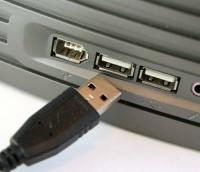| www.tmatlantic.com
Test & Soldering Equipment On-line Store |
|
D.E.V.I.C.E. (Wiki)Calculators Services |
|||||
Filter by first letter
|
USB (Universal Serial Bus)
USB features one "Universal" plug type for all USB peripheral-to-PC connections. Current operating systems all support USB, operating systems that are no longer supported by their makers may or may not support USB without modifications. Many devices get all of the software support they need from the OS, but there are some that will come with a floppy or CD with specialized drivers for that particular device. Don't worry about getting the right software because the OS's that support USB always know how to determine if anything else is needed and they will help you get the software loaded so the device works correctly. At one time there was some limited support for USB on Windows 95, but that is no longer available. USB is currently a key feature on virtually every new notebook. One great advantage of USB is that it allows notebook users to easily share peripherals. USB carries data at the rate of 12 megabits per second, which is sufficient for "medium to low-speed peripherals". This broad category includes telephones, digital cameras, modems, keyboards, mice, digital joysticks, some CD-ROM drives, tape and floppy drives, digital scanners and specialty printers. USB's data rate also accommodates a whole new generation of peripherals, including MPEG-2 video-base products, data gloves and digitizers. Computer-telephony integration is expected to be a big growth area for PCs, and USB can provide an interface for Integrated Services Digital Network (ISDN) and digital PBXs. Technically, you can connect up to 127 individual USB peripherals at one time. Due to the fact that some devices reserve USB bandwidth, the practical maximum of devices is less than the theoretical maximum. However, PCI-USB add-in cards provide an independent USB bus to which even more peripherals can be connected. How fast is USB? High speed USB products have a design data rate of 480 Mb/s. Full speed USB devices signal at 12Mb/s, while low speed devices use a 1.5Mb/s subchannel. The fastest connection commonly found on PCs is UltraIDE (33MBYTES/s), which is used for hard drives and CD-ROMs. In practice, the USB specification limits the length of a cable between full speed devices to 5 meters (a little under 16 feet 5 inches). For a low speed device the limit is 3 meters (9 feet 10 inches). When USB was designed, a decision was made to handle the propagation of electromagnetic fields on USB data lines in a way that limited the maximum length of a USB cable to something in the range of 4m. This method has a number of advantages and, since USB is intended for a desktop environment, the range limitations were deemed acceptable. USB official website (USB Implementers Forum, Inc.) - http://www.usb.org/home. |
Site mapPrivacy policyTerms of Use & Store PoliciesHow to BuyShippingPayment




|

























